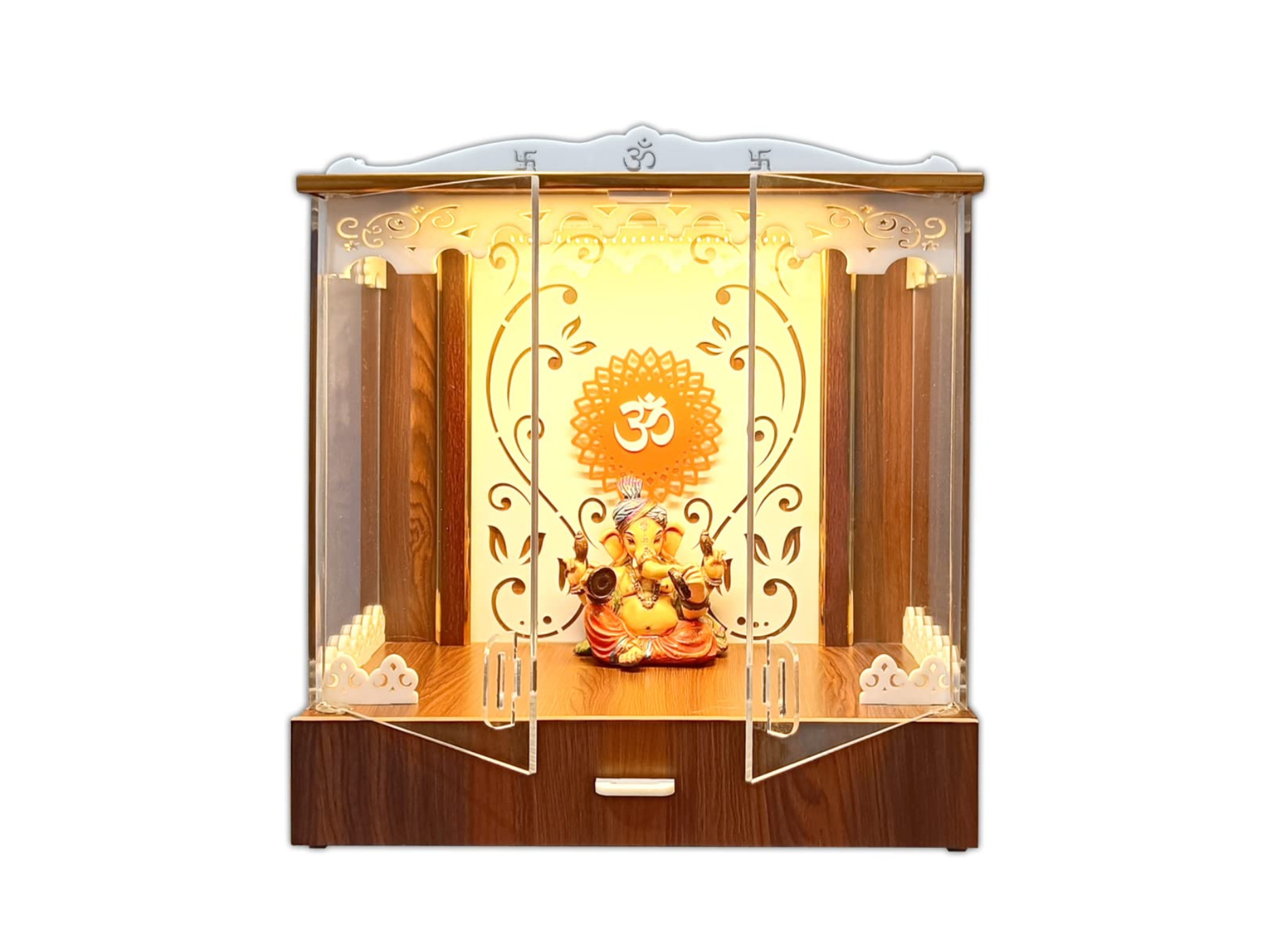When it comes to spiritual heritage, we have a thought how many Shiva Temples are there in India ? India stands out as a land of diverse traditions and rich cultural history. Among the numerous deities worshiped in the country, Lord Shiva holds a significant place in the hearts of millions. The presence of Shiva temples across India not only showcases religious devotion but also architectural brilliance. In this article, we present a comprehensive guide to the count and significance of Shiva temples in India in 2023.

Crafted from premium materials, this exquisite wooden home temple is an ideal selection for your sacred rituals. You have the flexibility to choose the perfect spot within your space to create a serene prayer corner that aligns with your preferences. Elevate your home decor by adorning this temple, enhancing its elegance and charm. If you’re in search of a lightweight, top-quality, and budget-friendly pooja mandir, our Home Temple stands as the ultimate choice for you.
Unveiling the Divine Abodes: India's Shiva Temples
India, with its tapestry of traditions and beliefs, is home to countless Shiva temples that vary in size, historical significance, and architectural marvel. These temples not only serve as places of worship but also as cultural landmarks, narrating stories of devotion and artistic mastery.
Shiva Temples in India: A Mosaic of Devotion
When we are thinking that how many Shiva Temples are there in India ? The quest to determine the exact number of Shiva temples in India is akin to counting stars in the night sky – a truly challenging endeavor due to the sheer vastness of the landscape and the continuous addition of new temples. From the northernmost regions of Jammu and Kashmir to the southern tip of Kanyakumari, Shiva’s presence reverberates through every nook and cranny of the nation.
Tracing the Threads of Tradition: Indian Shiva Temples
The diverse cultures and regional variations within India have given rise to a plethora of Shiva temples, each with its own unique history and rituals. In Varanasi, the sacred Kashi Vishwanath Temple stands as a timeless symbol of devotion, while the ancient Shore Temple in Mahabalipuram whispers secrets of a bygone era.
Shiva Temples Across India: A Journey of Faith
Embarking on a spiritual journey across India, one can witness the unbreakable thread of faith that ties the nation together. The Amarnath Cave Temple, nestled in the Himalayas, beckons pilgrims with its naturally formed ice Shivlinga, while the cavernous Elephanta Caves house awe-inspiring sculptures that narrate mythological tales.

Temples offer a pragmatic approach to enhance both your home’s decor and storage solutions. Embrace your creative flair and adorn your walls with a touch of design. This uniquely crafted temple adds a touch of opulence to your living space, radiating a sense of warmth, peace, and spiritual essence.
Counting the Divine: How Many Shiva Temples Are There in India?
As of 2023, a definitive count of Shiva temples in India remains elusive. The number is dynamic, with new temples being constructed and ancient ones being restored. However, estimates place the count at several hundred thousand. It’s essential to note that each of these temples contributes to the spiritual tapestry of India, weaving a story of devotion, artistry, and cultural heritage.
The Significance Beyond Numbers
Beyond the sheer quantity, Shiva temples hold immense significance for the people of India. They are not just places of worship; they are embodiments of artistic brilliance, devotion, and the cultural roots that bind the nation. The rhythmic chants, the fragrance of incense, and the intricate carvings tell tales of centuries-old traditions that continue to thrive.
Exploring Architectural Marvels: Shiva Temple Designs
The diversity of India’s Shiva temples extends beyond their numbers. Each temple boasts a unique architectural style that reflects the culture and history of its region. The intricate carvings of Khajuraho’s Kandariya Mahadeva Temple, the towering gopurams (entrance towers) of Tamil Nadu’s Meenakshi Temple, and the serene elegance of Odisha’s Lingaraja Temple are just a few examples of the architectural brilliance that adorns Shiva temples across India.
Rituals and Celebrations: Worship at Shiva Temples
The devotion to Lord Shiva is not limited to the physical structures; it’s an experience that comes alive through rituals and celebrations. From the rhythmic recitation of the “Rudram Chamakam” to the vibrant festivities of Maha Shivaratri, Shiva temples provide a space for devotees to connect with the divine. These rituals often have deep spiritual meanings and are a testament to the enduring faith in Lord Shiva.

An elegant home or office pooja mandir is certain to elevate the surrounding positive energy. The modern design of this wall-mounted home mandir, coupled with the skillful teak texture craftsmanship, is sure to capture attention. This roomy home/office puja mandir provides ample space for idols, figurines, bells, diyas, agarbattis, and more.
Preserving Ancient Traditions: Role of Shiva Temples
Shiva temples serve as custodians of ancient traditions and cultural practices. The priests, often considered as bridges between the mortal and divine realms, play a crucial role in maintaining the sanctity of these practices. The oral transmission of Vedic hymns, the art of sculpting intricate idols, and the knowledge of ancient healing practices are preserved within the hallowed walls of these temples.
Pilgrimage and Tourism: Shiva Temples' Cultural Impact
Beyond their spiritual significance, Shiva temples contribute significantly to India’s cultural and economic landscape. Many of these temples have become pilgrimage sites, attracting millions of devotees and tourists annually. These visitors not only seek spiritual solace but also contribute to local economies, supporting businesses that have sprung up around these revered sites.
Symbolism and Philosophy: Shiva Temples' Teachings
Shiva temples are not just repositories of art and history; they also impart profound philosophical teachings. Lord Shiva’s representation as both the destroyer and the creator embodies the cyclical nature of existence. His consort, Parvati, symbolizes the balance of cosmic forces. These teachings encourage individuals to find equilibrium in their lives and accept the transient nature of the world.
Continuing Legacy: Future of Shiva Temples
As India continues to evolve, so does the legacy of its Shiva temples. Efforts are being made to restore ancient structures, promote sustainable tourism, and ensure that the spiritual teachings remain relevant to contemporary society. The rise of digital platforms and virtual tours is also enabling people from across the globe to experience the majesty of these temples.

Enhance your sacred area with flawless decor. This captivating corner temple is constructed from durable solid wood and meticulously adorned with exquisite hand-painted details. The opulent blend of gold and white hues, adorned with intricate white motifs, creates a stunning visual contrast. The unit includes two pull-out drawers for storing your essential pooja items. Infuse spirituality into your living space with this divine wooden home temple, featuring a meticulously hand-crafted KAMDHENU motif that makes it a perfect addition to your pooja ghar. Invite a sense of spirituality into your home with this impeccably handmade, divine home temple.
In Conclusion
In the vast expanse of India, where spirituality and culture intertwine, the number of Shiva temples might be a mystery that eludes a precise count. Yet, what is certain is that each of these temples, whether grand or humble, contributes to the spiritual heritage of India. The devotion, artistry, and unwavering faith they embody make them timeless beacons of a revered tradition that will continue to shine brightly for generations to come.
FAQs About Shiva Temples in India
The exact count of Shiva temples in India is ever-changing due to new constructions and restoration efforts. Estimates suggest several hundred thousand temples across the nation.
The Shivlinga, representing Lord Shiva, symbolizes both creation and destruction. It is a powerful reminder of the cyclical nature of life, encouraging devotees to embrace change and find harmony in the universe’s rhythm.
The Kashi Vishwanath Temple in Varanasi holds immense significance among Shiva devotees. Situated on the banks of the Ganges, it is believed that a visit here can liberate the soul from the cycle of birth and death.
The Amarnath Cave Temple, located in the Himalayas, is associated with an ancient legend. It is believed that Lord Shiva revealed the secret of immortality to his consort Parvati in this very cave.
Yes, many Shiva temples welcome visitors from all faiths. The spiritual aura, architectural beauty, and cultural significance make these temples a source of fascination for people interested in India’s diverse heritage.




